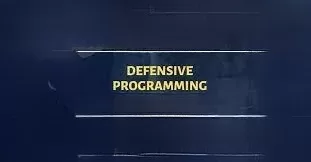Defensive programming is an odd combination of writing enough code while removing any extraneous code.
A set of logically organised instructions that the machine can use to carry out a specified task is all that programming is. Errors are unavoidable because the average software contains at least a few thousand lines. Coding errors can arise from both ineffective coding practises and can have severe effects on the code’s security, stability, and quality. Having guardrails is one of the best ways to prevent errors, particularly those that come more from the programmer than those that are prescribed. One programming technique that programmers frequently use to effectively handle faults is defensive programming.For a beginner, it is a component of programming, or standard programming. When you know what errors one can experience, normal programming can eliminate some errors and defects. A coder would be aware of the potential mistakes before checking for null or while validating user input. Unknown error is occasionally returned by embedded code, and the developer occasionally has a faint idea of why this is happening. Defensive programming steps in to save the day.
Defensive programming: what is it?
It is a programming technique designed to guard against mistakes and weaknesses in software development for unforeseen circumstances. Defensive programming enables programmers to identify potential security anomalies so that the software can react in a certain way. Defensive programming techniques involve an odd mix of cutting out superfluous code while making sure there is enough written to cover all potential user behaviours. In addition, the code must to be simple to audit for thorough testing.
Why should we be on the defensive?
Coding errors can be characterised, despite being unforeseeable. They occur when a client’s requirements change frequently, when infrastructure needs to be replaced, when there is a deadline, or they may be caused by legacy problems. Even just resolving the following problems may help you from giving up when the right code doesn’t work out as you had hoped.
Incorrect entry: The right input leads to the right result. Nobody can argue against that. But in the end, human error is rather remarkable. Developers play into this issue by incorporating the necessary user entry validation.
Invalid operations:
Passing the proper parameters to the relevant operations is the only way to prevent obtaining invalid outcomes. Performing unit testing thereafter adds another level of quality.
System failures:
There is always a chance that the system will fail and remove the code with it. Defensive programming includes several exceptions, such as checks and manage, that are introduced. For example, before saving data, defensive programming checks the network’s availability, calls an exception when the network is down, and saves data locally until the network is back up.
Potential developers
A project is reviewed and refactored by the new team when it changes hands. If sophisticated code is not expressed clearly, it can be changed without considering the consequences to the code. It occurs when a novice developer attempts to modify the code without having a thorough understanding of it. A defensive programmer will make sure the code is easy to understand while keeping these challenges in mind.


 WhatsApp us
WhatsApp us